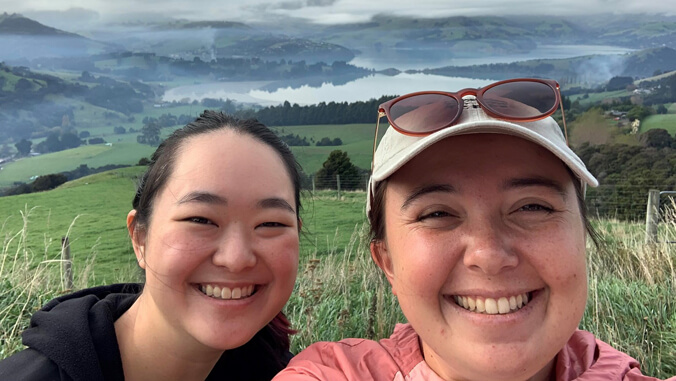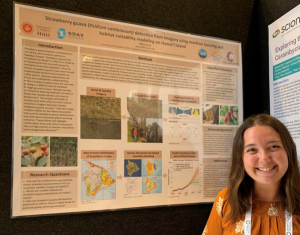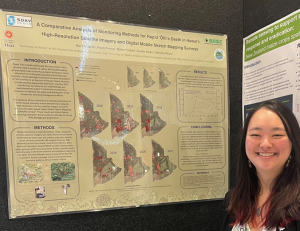
UH Hilo grad students present invasive species research in New Zealand
Two graduate students from the University of Hawaiʻi at Hilo tropical conservation biology and environmental science program joined scientists from around the world who gathered in Aotearoa New Zealand in May to share new findings on invasive alien species and their impact on biodiversity, ecological systems and food production. Olivia Jarvis and Naiʻa Odachi presented their research at the 4th International Congress on Biological Invasions.


Both budding researchers are investigating the use of satellite imagery to map the spread of invasive species in Hawaiʻi’s native forests. For Jarvis, it’s strawberry guava pushing out native trees, and for Odachi, it’s the fungus that causes Rapid ʻŌhiʻa Death, which is killing—at an alarming rate—a culturally and environmentally important tree in Hawaiʻi.
The students’ mentor, Ryan Perroy, a professor of geography who specializes in aerial imagery of vast and remote native forests suffering from Rapid ʻŌhiʻa Death, accompanied the two students to the meeting. Perroy is principal investigator at the UH Hilo Spatial Data Analysis and Visualization laboratory (SDAV), a research unit applying geospatial tools to local environmental problems in Hawaiʻi and the Pacific region.
“Being able to present at an international conference was an incredible opportunity that allowed me to share the work our lab does with a larger audience,” said Odachi. “Additionally, it was amazing to hear about ongoing research that scientists are conducting, not only in the United States but also in other countries.”
“I had the opportunity to have interesting conversations and make some meaningful connections with scientists from around the world,” Jarvis said. “I learned a lot from talks on invasive species work from other countries and found a small community of scientists there interested in how to use machine learning and species distribution modeling to answer questions about alien plant species and climate change, similar to my project.”
Multiple funding sources
Jarvis’s funding for the trip came from the Hawaiʻi Data Science Institute and through Perroy’s SDAV lab. She also received support from a National Science Foundation cybertraining award through UH Mānoa that is being used across the UH System to create workshops and curriculum for undergraduate and graduate students to increase cyberinfrastructure skills across environmental science fields.
Conference fees and accommodations for Odachi were covered by The New Zealand Institute for Plant and Food Research. Her trip was also supported by the Hawaiʻi Department of Land and Natural Resources (DLNR) and funding through the SDAV lab. DLNR provided funding for Perroy to attend the conference, where he also presented his research on Rapid ʻŌhiʻa Death.
To read more, visit UH Hilo Stories.
—By Susan Enright
